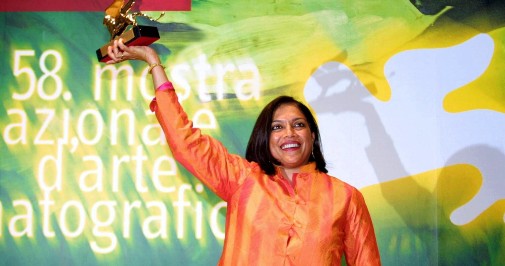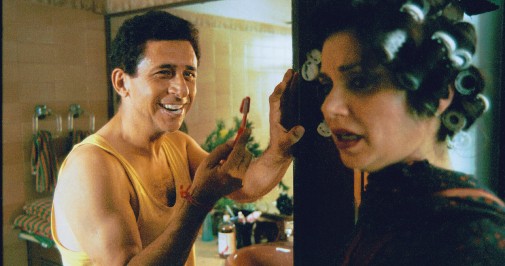
Last year, Chloé Zhao won the Golden Lion at the Venice Film Festival for Nomadland. Unlike Cannes, which only awarded one woman (Jane Campion for The Piano) with the Palme d'Or in its history, Venice has named five female directors as the grand victors of its main competition. One of them, Mira Nair's Monsoon Wedding, I hadn't seen. Since the Criterion Channel has just added Mira Nair's 2001 Venice-winner, it seems like a good time to correct this lacuna. Without further ado, let's delve into the rainy festivities of this Monsoon Wedding…

Opening credits seldom get the respect they deserve, but good design and intelligent music choices can quickly establish the tone for a film, calibrating the way an audience relates to the subsequent motion picture. Monsoon Wedding is a prime example of this art. Colorful graphics fill the screen while the words slide through it in contrasting motion, playfully dancing before our eyes to the sound of Mychael Danna's jubilant score. It's a joyous sight, vibrant and full of life, setting our expectations for a frothy ecstasy of romance and Indian melodiousness.
What's to come doesn't contradict such initial feelings, but it doesn't present uncomplicated exultation either. In contemporary New Dehli, an upper-class family is preparing an enormous wedding for their daughter. It's an arranged marriage and the ceremony is to be attended by several members of their extended family, guests coming from as far as Australia and the US. In the eye of this storm of perilous event-planning, the patriarch Lalit Verma is especially stressed-out, opening the film by screaming into his phone.

His worries only increase as the ceremony keeps getting bigger and he finds himself borrowing money from friends to pay for all the splendor. As for the bride, she's having doubts, though a happy ending is in her future for this is a film intent on putting a smile on its spectator's face. There are also Alice and Dubey, two working-class people existing in the periphery of the Verma clan, who end up falling in love during the wedding preparations. They offer a contrasting vision of romance, spontaneous instead of arranged by careful family negotiations.
Director Mira Nair and screenwriter Sabrina Dhawan reconfigure what could have easily been a simple rom-com premise into a henna-colored mural of familial unity and disunity, amorous abandonment facing off against weary pragmatism, innocent fun stabbed by the blade of past trauma. It's a tonal tapestry whose intricacy demands respect for ambition alone, though this is not a case of good intentions spoiled by subpar execution. Nair's camera flies through the crowded rooms, jumping from person to person, from gesture to gesture, rarely settling in serene contemplation.

The image is thus an active participant in the mess of the wedding. Instead of a distant observer, it trembles with enough nervous energy to power a city district. This riotous vitality is further intensified by the saturated colors of Declan Quinn's cinematography, each marigold shining like a flowery flame.
None of this would work without sharp rhythms or a cast capable of handling the swerves of genre, of emotion, of pure feeling. Thankfully, editor Allyson C. Johnson and the collection of actors Nair chose are up to the challenge. The climactic wedding is especially gorgeous in terms of cutting and performance, a dream of juxtaposed narratives, stories of class differences, melodramatic fervor joining hands in matrimony.

Notice the exhausted mirth coming off Naseeruddin Shah's Lalit which is as heartbreaking as it is heartwarming. In the same instant, the relief on Shefali Shah's face is a monument to souls liberated from the claws of silent suffering. Those two are the MVPs, but one could write similar praise about all actors who parade in front of Nair's camera. There's a nearly Altman-esque quality to the controlled chaos and sprawling humanity of Monsoon Wedding, its dense textures, cultural specificities, multitude of brightly sketched characters, lived-in performances running crossed paths through the flick.
Of course, comparing filmmakers to each other isn't always productive. When comparing a female artist to a man, there's an added layer of wrongness to the whole endeavor. Nair's craft may remind me of Altman, but her achievement is all hers. It's a singular feat that makes one long to watch all of the director's filmography, chase down her more obscure titles in search of other miracles that spark as brightly as Monsoon Wedding. Finally, after all this talk of spectacular disarray and explosive energy, we should also pay attention to this picture's quieter pleasures.

Amidst the flurry of preparation and musical numbers blossoming from happy sisterhood, Nair keeps finding little gestures, apparently inane things that deepen her study of colliding lives. One thinks of the streets of New Dehli glistening like a black diamond surrounded by Christmas lights. Dreams of the way many workers eat fallen marigolds, the citrusy Saffron of the poor. Recalls the bride running from her party to spend one last night of lust under a vaulted ceiling of rain and moonlight. Such moments allow for a breath, a sight, precious variation from the surrounding excitement. They are the pause in the symphony, the blank space in the mural, the comma that allows a poem to flourish and conquest our heart without reservation. In those pauses, I fell in love with this film.

Are you familiar with Mira Nair's Monsoon Wedding? If so, do you think this Venice champion deserved to have had an awards trajectory like that of Nomadland?